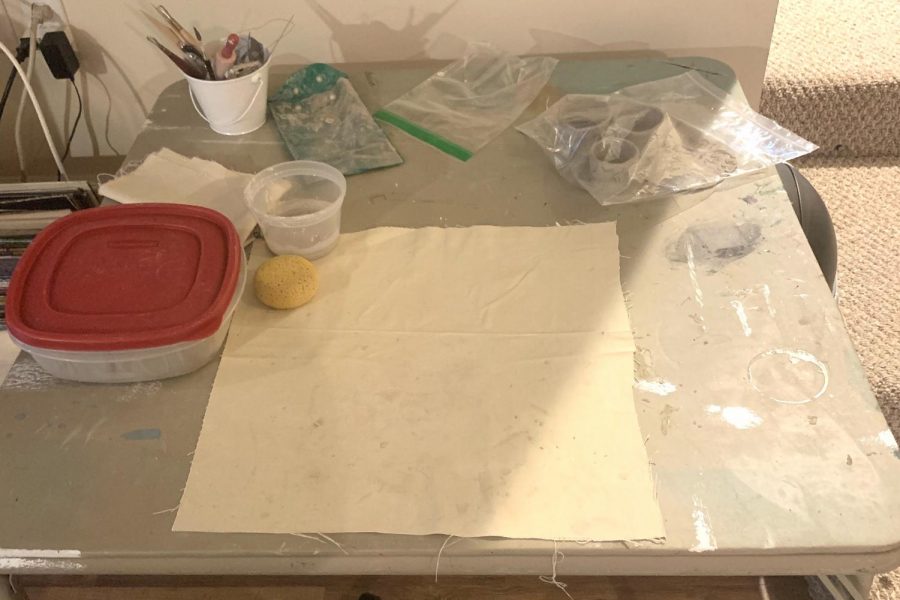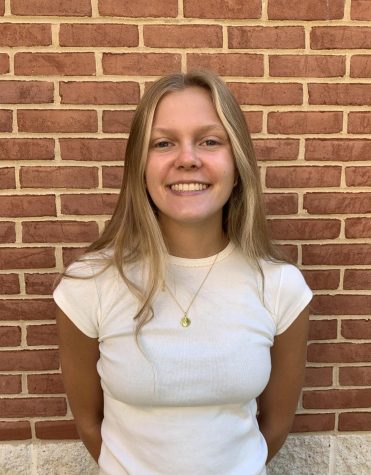Arts department utilizes creativity to work around virtual learning challenges
Freshman Helen Kelly’s at-home ceramics workspace. Ceramics students have set up areas to work on projects.
October 14, 2020
This semester, there won’t be bustling halls or student-filled classrooms. The parking lot will remain largely empty, and the few people allowed in Whitman will be administrators, building service and the miscellaneous teacher collecting office supplies.
As the Whitman community begins to grapple with the long-term effects of the coronavirus pandemic, the art classroom environment will shift almost entirely into students’ and staff’s homes. Instead of eyeing a blank canvas in the decorated art classrooms, students must watch a teacher’s hand mundanely trek across their computer screens. Left without materials and a proper workspace, art students and teachers alike are facing an uncertain start to the school year.
Art programs are meant to be hands-on, not done through a screen, said studio art teacher Robert Burgess. Still, art classes are finding ways to work through the perils of teaching highly demonstrative and visual courses online.
The most immediate issue is the absence of proper materials or workspace for students to complete their assignments, said Kathleen Mulholland, who teaches both ceramics and Foundations of Art. Fortunately, Whitman staff were able to distribute necessary materials at the beginning of the school year.
On September 19, ceramics students stopped by Whitman to pick up a hefty load of tools: sculpting utilities, two pieces of canvas, sketchbooks and varying amounts of clay. Mulholland also had the students create spacious at-home studios where they could work on their projects, she said.
“The first assignment, which is really silly, is to photograph their workspace,” Mulholland said. “I did that so I could see where they’re working, and then troubleshoot because I don’t want them working on a dining room table.”
In a regular year, Mulholland is able to walk around the classroom and show students the correct techniques for creating their art. This, of course, is no longer an option. Mulholland has taken two measures to make her class easier on students: she has scaled down the size requirements for student pieces and taken a more lenient stance on grading, she said.
Ceramics classes also require a kiln, a large oven used to “fire” pottery works into their hardened final state. Normally, students place their finished projects in the ceramics room kiln at school, but in the age of virtual learning, there’s no direct access for firing. In response, Mulholland devised a plan: students will drop off pottery at Whitman, where staff members will fire the pieces.
“The clay projects need to be fired so they don’t fall apart,” freshman Helen Kelly said. “Now, it’s going to take a lot more time for us to be able to finish assignments.”
Studio art students are also feeling the strains of virtual learning, especially missing the course’s in-person structure. The classroom’s environment in a typical year is highly independent yet feed-back driven, junior Leo Levine said.
“Not being in the room is the worst part,” he said. “Not being able to check in with Mr. Burgess as much about pieces, it’s more difficult to get critique which is really important.”
Even with unprecedented setbacks, Burgess is working tirelessly to keep his online classes as similar to the in-person version as possible, he said. Over Zoom, students enrolled in the foundational levels of studio art have been practicing sketching and drawing, while those at the AP level have been focusing on a concentration — a topic that they will explore in-depth through their artwork — for their portfolio.
“Projects across all levels will be adjusted as needed due to availability of materials, while the objectives will remain the same,” Burgess said. “Feedback, critiques and demonstrations will continue to occur and be more fluid once we settle in with the technology.”
Even more freeform courses are adapting to the out-of-classroom structure. Photography students have migrated from school-provided film cameras to their own cell phones to avoid constant supply runs to Whitman. Instruction, however, has largely been unaffected; students are continuing to learn the same compositional techniques they would practice in class. Additionally, this year’s photography projects will focus more on shooting color photos as opposed to black and white, film-based photography. Katherine Kern, a Digital Art and Photography 1 teacher, sees cell phone use as an advantage because it allows for students to make more mistakes and learn from them.
“Normally I’m like, ‘here’s a roll of film that has 24 shots, choose wisely,’” Kern said. “With digital it’s like ‘just take them and delete the ones you don’t like.’ There’s a little more room for error.”
Kern is most excited to introduce an original project to students this year — to photograph fall scenery and capture the unique feelings that come with the beginning of autumn. The incorporation of color is a necessity to this project, and will encourage introspective thinking about how photos invoke emotion, Kern said.
Many of the initial difficulties online art classes faced last year may continue, and additional problems may arise, Mulholland said. However, teachers and students will continue working together to recreate the environment of in-person classes as best they can and, while they’re at it, create some beautiful art.
“It’s difficult, and there’s going to be some challenges,” Kelly said. “But we already have the clay at home, and we’re already making pieces. I’m sure we can figure out the rest of the year too.”










